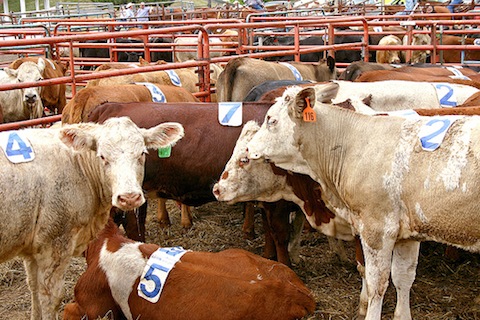
The world’s population hit seven billion at the end of last year, an increase of one billion in a mere 12 years. As the population continues to grow, food security will remain one of the most pressing problems of the 21st century. Malthusians might have a point in being concerned: The challenge of feeding seven billion-plus people is likely to become more difficult as environmental degradation and desertification carry on – and competition for crops increases. Food prices have soared in the last five years and increasing demand for alternative fuels further aggravates the situation. Food production has so far kept pace with population growth however, though the total area of land given to arable use has remained almost constant for decades. How long this can continue is not certain.
An important part of the human diet are livestock products, which account for 13% of the calories consumed worldwide and for 20% in developed countries. Meat production increased by 23.6% in the last decade, mainly driven by growing demand in China and Brazil, two countries which account for more than three-quarters of the yearly growth in meat output. In 1961, China’s per capita meat consumption was 3.8 kg; by 2002 it had increased to 52.4 kg. To meet this growing demand for animal products, factory farms and intensive farming methods are necessary. Besides the ethical concerns raised by these farming methods, such practices also cause a number of environmental and social problems.
Industrial meat production is inefficient: Livestock actually remove more from the food chain than they provide, and consume more protein than they produce. An important part of the problem is therefore changing the way meat is produced. While traditional herding and livestock breeding relies on resources of little value for human consumption, modern forms of intensive farming require enormous amounts of water, land, and feed. Huge areas of land are being used for the production of feed crops such as soybean and corn, thereby increasing the stress on natural resources and intensifying competition for crops. Modern large-scale meat production might be efficient from a business perspective; it is unsustainable and inefficient in environmental and developmental terms.
But there is another side to livestock raising: A great share of the world’s poor depend on livestock for survival. Herding livestock does not require formal education or large amounts of capital and is often the only economic opportunity available to people in developing countries. Livestock also indirectly contribute to the food supply chain through their use as working animals and as suppliers of fertilizer. But subsistence livestock raising is not without problems either; in many parts of the developing world it is a major cause of resource overuse and environmental degradation.
It is nevertheless important to distinguish between industrialized commercial meat production and subsistence farming. While livestock raising is a matter of survival for the poor, industrialized meat production is driven by the desire for cheap meat. However, as long as consumers in the developed world are not aware of the consequences of their behavior, farming methods are unlikely to become more sustainable.
See also:
Feeding China’s Pigs – Institute for Agriculture and Trade Policy (IATP)
Livestock’s Long Shadow – Food and Agriculture Organization of the United Nations (FAO)
FAO Food Outlook – Food and Agriculture Organization of the United Nations (FAO)
Livestock in Food Security – Food and Agriculture Organization of the United Nations (FAO)
Meat by Numbers – The Guardian
The Meat Industry – The Guardian

